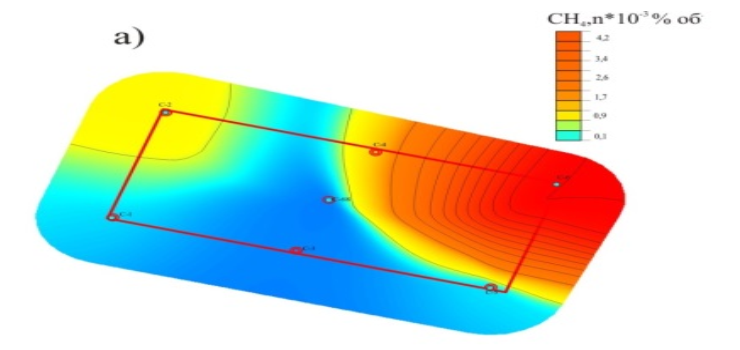Soil vapor survey as part of environmental engineering survey is carried out in areas where fill-up soils are spread, with the presence of construction, industrial debris, and household waste (areas of unauthorized household dumps), wetlands with a capacity of more than 2.0-2.5 m. Soil vapor survey is also carried out in natural gas unloading areas and wetlands.
The main danger of using fill-up soils emanates from its ability to generate biogas, consisting of combustible and toxic components. The main ones are methane and carbon dioxide, with impurities such as heavy hydrocarbon gases, nitrogen oxides, ammonia, carbon monoxide, hydrogen sulfide, molecular hydrogen, etc. Biogas is formed during the decomposition of “household” organic matter as a result of the vital activity of anaerobic microflora in the earth cover at a depth of more than 2.0-2.5 m. Aerobic oxidation of organic and biogas products takes place in the upper aerated layers of the earth strata.
Biogas is sorbed by enclosing fill-up soils and sediments of natural origin dissolves in groundwater and perched water and dissipates into the surface atmosphere. When building on fill-up soils, there is a danger of biogas accumulation in technical underfloor spaces of buildings and engineering communications up to the fire and explosive concentrations in methane (5-15% at O2 12.1%)1 or up to toxic contents (above MAC) of individual components.
The following is performed to assess the degree of vapor hazard of fill-up soils, to determine the feasibility and conditions for the use of this area for construction, as well as to develop a system of measures to protect buildings from biogas and ensure environmentally friendly living conditions of the population:
- various types of surface gas surveys (drill, emission), accompanied by a sampling of ground air and surface atmosphere;
- borehole gas and geochemical studies (with a layer-by-layer sampling of ground air, soil, groundwater);
- laboratory studies of the component composition of free groundwater, the gas phase of soils, dissolved gases, and biogas, dissipating to the surface atmosphere.
Gas and geochemical zoning of the territory (delineation of zones of varying degrees of danger in the soil massif) is carried out based on studying the surface and deep structure of the gas field.

